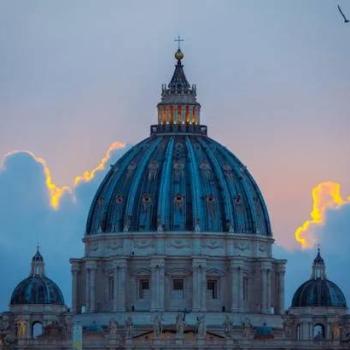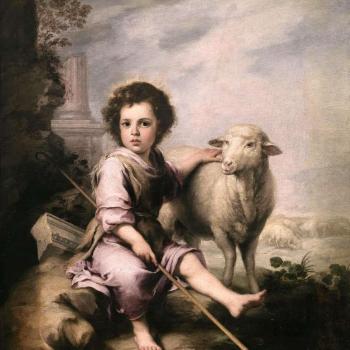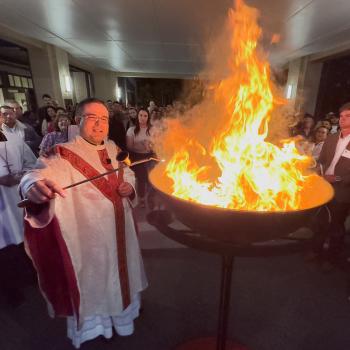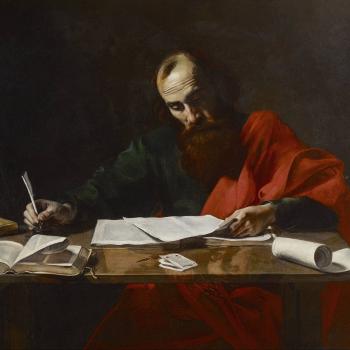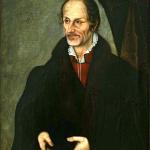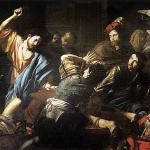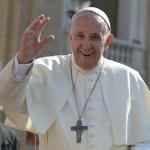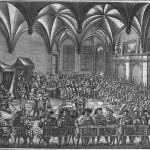Last week I did a presentation at my parish on the history of the Veneration of the Blessed Virgin Mary. I presented a condensed version of this paper I wrote in seminary titled “The Marian Cult and the Second Vatican Council.” I hope you find it informative and don’t be afraid of the word cult, it simply means organized veneration.
Introduction
Since apostolic times, Mary, the virgin mother of God, has been greatly honored by Christians. The Second Vatican Council, recognizing the need in the modern Church for this much-loved ancient cult of Mary, explained and addressed it in chapter eight of the Dogmatic Constitution Lumen Gentium. Examining the state of Mariology, in particular the Marian cult, before, during and after the Second Vatican Council provides the best structure for the treatment of the teachings and theology found in paragraphs sixty-six and sixty-seven of Lumen Gentium. An overview of the history and development of the cult provides the context in which the Constitution considers the cult. With Mariology entering the 1960s at a high-point, the Council itself gave great importance to the cult of Mary in particular by invoking the sensus fidelium to determine proper practices to venerate the Blessed Mother. Despite the clear presentation of Marian teaching at the Council, the cult of Mary greatly diminished soon after baffling many. This sharp decrease has prompted the Holy Fathers to promote Marian devotion strongly, in particular the Rosary, by exhorting the faithful and encouraging priests to do the same.
1. Definition
Lumen Gentium is clear in what is meant by cult, avoiding ambiguous language that may confuse Mary’s relation to God. The text reads, “This cult, as it always existed, although it is altogether singular, differs essentially from the cult of adoration which is offered to the Incarnate Word, as well to the Father and the Holy Spirit, and it is most favorable to it.” With these words, the document in making the classical distinction between latria, dulia and hyperdulia which distinguishes the adoration due to God alone from the honor due to creatures. Latria, or adoration, is the worship and homage that is rightfully offered to God alone since it is the acknowledgement of the excellence and perfection of a divine person. Dulia, or veneration, on the other hand, refers to the excellence found in a created person that deserves recognition and honor. Theologian Mark Miravalle notes that sometimes the word “worship” is used to refer to both latria and dulia causing confusion. It is sometimes found to mean “adoration” and other times “veneration.” He recommends being clear in the use of the word “worship” by saying either “worship of adoration” or “worship of veneration.”[1] Within the category of veneration, there is a unique level of veneration for the Virgin Mary that denotes the honor due to a created person whose excellence goes beyond every other created person. This is hyperdulia. Mary remains inferior to the adoration given to God, yet the veneration of her remains always superior to that due to any other created being.
2.1 History – Beginnings
In paragraph sixty-six, Lumen Gentium provides the historical background of the cult of Mary: “Clearly from earliest times the Blessed Virgin is honored under the title of Mother of God, under whose protection the faithful took refuge in all their dangers and necessities.” Having first clarified what is meant by the cult of Mary, it is now possible to speak of its origins and history. This cult has been present in the Church from the beginning and has experienced many developments over time. The Mariological Congress of Lisbon of 1967 stated that “the cult of Mary had its origins in the Scriptures, and that the primitive Church already venerated Mary; but it is from the time of the Council of Ephesus (431) that a new development puts in its appearance.”[2]
Passages in Scripture quickly led to a certain cult of Mary since the Gospels surely affirm a special excellence found in her that other human beings to do not have, primarily being the virgin mother of Jesus. The salutations of the archangel Gabriel and Elizabeth, which now make up the Hail Mary, give Mary great reverence and honor. The key Scriptural passage signaling the esteem and unique honor all Christians show Mary is the Magnificat of Luke’s Gospel. The evangelist would have never written “all generations will call me blessed” if already the first generation of Christians did not venerate Mary. This exclamation by Mary is in accordance with the earliest rule of faith and oral tradition of the Christian community. These passages recorded in Sacred Scripture are among the seeds of the cult of Mary that served to further the development of her cult throughout subsequent centuries.
Early mentions of Mary by the Church Fathers focus on Mary’s virginity and divine motherhood. Saint Ignatius of Antioch stressed that the Son of God was born of a Virgin. In his letter to the Church of Smyrna he writes, “born of Mary and born of God… Jesus Christ our Lord.” and in his letter to the Ephesians he records the three resounding mysteries of God, “The virginity of Mary, the nativity and the salvific death of the Savior.” Irenaeus speaks of parallelisms between Eve and Mary and baptismal creeds mention the Virginal birth of Christ. [3] Origen declares the womb of Mary to be “worthy of the greatest respect” (Luke Homily 14, 8). Saint Ambrose presents Mary as a model to be followed by all virgins in De Virginibus ad Marcellinam.[4]
This early evidence of the cult of Mary is recognized by the Council and is also identified by Pius XII in the footnoted encyclical Ad Caeli Reginam. The Holy Father wrote, “From the ancient Christian documents, from prayers of the liturgy, from the innate piety of the Christian people, from works of art, from every side We have gathered witnesses to the regal dignity of the Virgin Mother of God; We have likewise shown that the arguments deduced by Sacred Theology from the treasure store of the faith fully confirm this truth. Such a wealth of witnesses makes up a resounding chorus which changes the sublimity of the royal dignity of the Mother of God and of men, to whom every creature is subject, who is exalted to the heavenly throne, above the choirs of angels.”[5] Despite this, the co-redactor of Lumen Gentium’s Chapter VIII, Monsignor Gerard Philips, as well as other theologians, question if there is enough evidence to consider the presence of a Marian cult in the very early Church.[6] Carmelite Anselm Burke writes, “Out of knowledge has come the greater manifestation of love for Mary. Our present modes of honoring her are the outgrowth of centuries of pious meditation upon her privileges. Yet, while our present manner of expressing our reverence for Mary is not something which was had in Apostolic times, we would be wrong in thinking that devotion to her is something new in the Church.”[7]
Philips and Burke look for an established and documented cult such as the cult to martyrs, which began very early in the Church when their intercession was sought. Philips and Burke see this presence of Mary in the earliest years as the cult of Mary in seminal form and not a mainstream cult. There is clear evidence of a cult to the martyrs before a cult of Mary, yet with the conviction of the communion of saints, it seems absurd to state (even though there is no evidence) that Mary’s intercession was not invoked early in the Church as a member of the communion of saints.
2.2 History – Developments
The earliest recorded prayer seeking the intercession of the Virgin Mary, the Sub Tuum Praesidium, is found in a fourth century papyrus. This beautiful prayer reads, “Beneath the cover of his mercy we take refuge, Mother of God, do not reject the requests that in our predicament we address to you, but save us from danger, you alone pure, alone blessed.” The first use of the word Theotokos dates from about 325, the time of the Council of Nicea. It was only after the divinity of Christ was clearly taught at this council that the reflection on Mary’s role as the mother of Jesus expanded. Considering Mary in light of her divine son contributed to greater reflection and understanding of her role in the plan of salvation.[8] Saint Epiphanius, bishop of Salami and metropolitan of Cyprus in the late 4th century authored a work called ThePanarion where he wrote against various heresies. He mentioned in it Arab women who sin when they offer sacrificial loaves to the Mother of Christ because they treat her as a goddess rather than honoring her as a saint. Epiphanius concluded in the Panarion, “May Mary be honored, and the Word alone be adored.”[9] Epiphanius’ words demonstrate that the cult of Mary in the early Church clearly identified Mary as a creature worthy of veneration due to her unique excellence. Along with the Sub Tuum Praesidium and post-Nicean developments, it is evident that there was the presence of a well-developed Marian cult by the early 4th century.
The Council of Ephesus in 431 opened the floodgates for the cult of Mary. The first anathema of the council reads:
“If anyone does not confess that God is truly Emmanuel, and that on this account the Holy Virgin is the Mother of God [Θεοτόκος] (for according to the flesh she gave birth to the Word of God became flesh by birth), let him be anathema.”[10]
The emergence and diffusion of the title theotokos after the Council of Ephesus can only be understood in light of the divinity of Christ. Mary is not divine herself as the ancient mother-goddess Artemis whose monumental temple stood on the coast of Ephesus, but Mary rather was theotokos by grace, having been chosen among women to be the mother of the Incarnate Word.
Henri Barré notes that later developments in the cult of Mary never make Our Lady an end in itself, but rather remain strongly christological. Some of these include the 6th century communicantes of the Roman Mass: “reverencing first the memory of the glorious Mary, ever Virgin, Mother of God and of our Lord Jesus Christ,” and the preface of the Solemnity of Saint Mary [Octave of Christmas]: “By an admirable and ineffable mystery, the holy Virgin has conceived [O God] your only Begotten and has carried in her inviolate womb the Lord of heaven… Double is the grace in which she rejoices; she is astonished at having conceived while being a virgin, and she is full of joy at having given [the world] the Redeemer.”[11]
Apart from these two beautiful prayers, popular invocations and liturgical antiphons appeared in the early Middle Ages. The most popular prayer to emerge during the Medieval period is the Hail Mary, formed by the salutations of the archangel Gabriel and Elizabeth to Mary and a supplication for Mary’s prayers.
2.3 History – Marian Cult at Vatican II
Mariology enters Vatican II at a high point, not long after the proclamation of the dogmas of the Immaculate Conception and the Assumption. Marian Congresses since 1895 had become a point of theological discussion and expressions of Marian piety raising practical and theological questions and concerns regarding Mary. Paragraph sixty-seven of Lumen Gentium, as well as texts written before and immediately after the Council, speak of avoiding all “gross exaggerations as well as petty narrow-mindedness” when considering Our Lady.
Two extreme views about Mary were pulling strongly in opposite directions before the Council. Romano Guardini addressed one extreme in his 1957 book Prayer in Practice, “It was not a happy hour, when people thought that for the sake of Christ’s honor they had to minimize His intimate link with His mother.”[12] Pope Paul VI described the other extreme in a 1967 address on the nature of devotion to the Blessed Virgin, “There are those who exalt the devotion to Mary, at times in an excessive manner, and beyond the proper doctrinal and devotional limits.”[13] The intention of the Council was to address both extremes: irrational exaggeration or credulity on one hand and cynical unbelief on the other.
3. The Council
The two paragraphs of Lumen Gentium concerned with the Marian cult clearly note that this cult must be christo-centric and should avoid extremes. Gerard Philips asserts that the greatest innovation during the Council regarding the Marian Cult was the application of the recovered notion of the sensus fidelium.
Paragraph sixty-six approaches Mariology from a different angle, focusing on the faith of the people rather than dogmatic definitions or abstract conclusions. It has a strong historical approach tracing the emergence of the cult of Mary viewed from the practices of the faithful rather than official declarations and definitions. The language of the text shows that the practices of early Christians not only express what they believed, but also reveal what are appropriate practices today. Philips tells that the introduction of the subject of the sensus fidelium at the Council caused bitter debate because many Fathers feared it mirrored too much the erroneous idea that religious dogma was what the majority of people believed; a democracy of truth rather than objective truth.
Philips notes that to defend dogmas, theologians and the Church usually had invoked Scripture, the Church Fathers, the magisterium and councils, but seldom considered universal convictions of the faithful. Lumen Gentium, chapter two, paragraph twelve, brought back to light the sensus fidelium stating, “Thanks to a supernatural sense of the faith which characterizes the People as a whole, it manifests unerring quality when from the bishops down to the last member of the laity it shows universal agreement in matters of faith and morals.” This is a supernatural gift of the Holy Spirit granted to all believers, not a democracy of truth or a simple human collective expression of ideas.
Philips points out that the magisterium did invoke the sensus fidelium when defining the dogmas of the Immaculate Conception and Assumption, but before Vatican II, it rarely invoked it on matters of the cult of saints and the Blessed Mother. The Church did not invoke past practices of the faithful to determine what is appropriate today, but rather only concrete beliefs to determine what the Church believes.[14]
Titus Cranny agrees with Philips and cites the ancient maxim lex orandi, lex credendi when discussing this topic. Cranny rightly notes that these two short paragraphs of Lumen Gentium are extremely important. The prayer life of the Church, both devotions and liturgy, must be based on sound theology while at the same time, the ancient prayer of the Church reveals the faith of early Christians. It is in the early Marian practices of Christians that the ancient Church teachings regarding Mary are identified.
Cranny called these paragraphs “most important,” but they could perhaps be called “the most important” since they take Chapter VIII of Lumen Gentium into the source of Mariology. The early cult of the Virgin Mary expresses the Church’s ancient and seminal teachings on Mary, therefore a study of the development of the cult of Mary is essential in understanding Mary’s role in the history of salvation.[15]
Recognizing that devotions change over time, the Council gave preliminary directives on how to evaluate Marian devotions. Paragraph sixty-seven states, “Following the study of Sacred Scripture, the Holy Fathers, the doctors and liturgy of the Church, and under the guidance of the Church’s magisterium, let them [theologians and preachers] rightly illustrate the duties and privileges of the Blessed Virgin which always look to Christ, the source of all truth, sanctity and piety.” Lumen Gentium does not mention specific devotions apart from the indirect mention of Sub Tuum Praesidum which is footnoted. There is no mention of the rosary, scapular, Marian apparitions or shrines even as examples of popular expressions of the cult of Mary.
A last aspect found in these paragraphs is an ecumenical concern when treating the subject of Mary. Paragraph sixty-seven reads when addressing separated Christian brethren, “Let them [theologians and preachers] assiduously keep away from whatever, either by word or deed, could lead separated brethren or any other into error regarding the true doctrine of the Church.” There is great concern with portraying teaching on the cult of Mary clearly and plainly in order not to offend the separated brethren.
4.1 After the Council
Pope Paul VI restated and thoroughly explained in his Apostolic Exhortation Marialis Cultus of February 2nd, 1974, that Marian practices could change over time while providing a clarification of the previously quoted section of paragraph sixty-seven. Even though Marialis Cultus was not the first text by Paul VI on Mary after the Council, it may be the most complete. It provides an overview of the cult of Mary after the Council, elaborates on it and almost presents a commentary of paragraphs sixty-six and sixty-seven of Lumen Gentium.
The Pope identifies recent changes that have occurred in society that have affected manifestations of religious sentiment. He asserts that certain acts of piety that were once suitable are today inadequate or unsuitable due to new social and cultural patterns. The Holy Father states that these changes are permitted because they are new ways of “expressing the unchangeable relationship of creatures to their Creator.” This however, he admits, causes great, though temporary, confusion.
He continues by listing and explaining Marian liturgical feasts, which should not be intertwined with Marian devotions and acts of piety. These Marian pious acts must always remain Trinitarian, Christological and Ecclesial. He finally argues that the Angelus and Rosary are two exercises of piety worthy of undertaking that follow the principles given by Lumen Gentium and reinforced by him in Marialis Cultus. After the Council, many clergymen and faithful considered the Rosary an old and pious activity that had no place in the modern Church. Paul VI, as well as his successors, have presented the Rosary as the most appropriate devotion within the Marian cult, always demonstrating that it fulfills the parameters given by Lumen Gentium: its accordance with Sacred Scripture, the Church Fathers, the doctors of the Church, the Liturgy of the Church and under the magisterium.
As early as September 15, 1966, Paul VI in Christi Matri Rosarii wrote emphasizing the importance of the Rosary stating, “the Second Vatican Ecumenical Council, not explicitly, but quite clearly none the less, strongly recommended the Rosary to the souls of the sons of the Church in this statement, ‘they should consider of great importance the practices and exercises of piety toward her recommended by the Magisterium of the Church over the course of the centuries.’” The Council Fathers may have had the Rosary in mind when speaking of these practices, but since it was not explicitly mentioned, some, who probably for other reasons wished to see the Rosary wither away, found an opportunity to argue against it.
Pope John Paul II dedicated his pontificate to the Blessed Mother, taking as a motto “Totus Tuus Maria.” His Marian writings abound and of particular interest is the 2003 Apostolic Letter Rosarium Virginis Mariae where he declared the Year of the Rosary and gave the Church the five luminous mysteries of the Rosary.
In Rosarium Virginis Mariae, John Paul II states the Rosary does not take away from the centrality of the liturgy, but rather sustains the liturgy since its meditations prepare the heart for the sacrifice of the Mass. Devotional prayer is not in competition with the liturgical prayer. He also writes that the Rosary is not unecumenical because “when the mother is honored, the Son is known, loved and glorified.” Rather than being a hinderance to it, it will unite Christians and aid ecumenism.
He notes the Rosary is scriptural since the Our Father comes directly from Scripture while the Hail Mary is composed of Biblical salutations to Mary and a prayer asking for her intercession. Its mysteries are Christological and almost all come directly from Sacred Scripture. The Rosary is also meditational since its goal is the reflection of the Gospel. John Paul notes that it engages the whole person psychologically, physically, relationally and spiritually. It provides a source of meditation, which the contemporary western world is yearning for as seen in its outreach to alternative meditation techniques. The Pope concludes by calling all bishops and priests to promote the Rosary with conviction in order to contemplate the face of Christ through the eyes of Mary.
4.2 After the Council – Crisis
The decline of Marian devotion after the Council has evoked a quick and direct response from the Popes. A debate remains over why such a decline occurred when the documents of the Council surely did not degrade the Virgin Mary but should have refueled Marian devotion throughout the world. It seems when the Church spoke of changing practices and devotions according to changing social and cultural trends, some considered the Rosary old fashioned and believed it should be eliminated. Since it was not even mentioned in Lumen Gentium, some may have found evidence of this. The mass media played a crucial role in the diffusion of the documents from Vatican II and unfortunately sometimes the media reported erroneously. On October 1963 after the heated debate whether the treatise on Mary should be kept separate or be incorporated into Lumen Gentium, the New York Times ran the headline, “Council Votes to Downgrade Mary.”[16] This headline gave an impression incongruent with what actually happened at the Council, and in particular at that specific debate.
Even though the document does not state this, some may have adopted a view of Mary that made her too much like us to the point of stripping her from her unique role in the plan of salvation. Rather than divorcing her from her divine Son and creating a semi-divine cult for her alone, some divorced her from her divine Son to make her simply an example for faithful Christians to follow without recognizing her unique excellence as the Mother of God and an instrument for our redemption. Whatever the case may be, it is certain that Lumen Gentium teaches correctly and clearly the role of Mary in God’s plan of salvation, so error cannot be found in the document.
5. Conclusion
The cult of the Virgin Mary has developed throughout the centuries steadily as she prophesied to her cousin Elizabeth, “all generations will call me blessed.” Historical evidence confirms the presence of the Marian cult since apostolic times through to the Council of Ephesus, when the Church officially recognized Mary as the Mother of God. The two paragraphs of Lumen Gentium that address the cult of Mary recognize that pious practices may change over time while upholding the importance of venerating the Virgin Mary. The decline of the veneration of Mary after the Council may be attributed to various circumstances, including the reality that pious devotions have overall sharply decreased in the Western Church in the last forty years. Following the exhortations of Paul VI and John Paul II, the recitation of the Rosary must continue and ought to be encouraged. Marian devotion is not an option for the faithful Christian, but rather, it plays an intrinsic part in understanding the mystery of salvation without taking away from the adoration due to the Triune God.
Bibliography
Barré, Henri. “Origin of Marian Cult in the West.” The Marian Era 9 (1969): 11-13, 100-104.
Besutti, Giuseppe. “Mariology and Marian Cult from 1854 to Vatican II.” The Marian Era 9 (1969): 14-19, 72-78.
Burke, Anselm. Mary: In History, In Faith and In Devotion. New York: Scapular Press, 1956.
Cranny, Titus. Is Mary Relevant? New York: Exposition Press, 1970.
“Dogmatic Constitution on the Church: Lumen Gentium” in The Sixteen Documents of Vatican II. Marianne Lorraine Trouvé, ed. Boston: Daughters of Saint Paul, 1999.
John Paul II, Pope. Rosarium Virginis Mariae. 16 October 2002.
Miravalle, Mark. Introduction to Mary: The Heart of Marian Doctrine and Devotion. Santa Barbara, CA: Queenship Publishing, 1993.
Most, William. Vatican II: Marian Council. Athlone, Ireland: Alba House, 1972.
Paul VI, Pope. Marialis Cultus. 2 February 1974.
Philips, Gerard. “The Sense of Faith and the Cult of Mary” The Marian Era 9 (1969): 8-10, 55-62.
Spiazzi, Raimondo. “Mary’s Shrines after the Council.” The Marian Era 9 (1969):44-45, 99-100.
[1] Mark Miravalle, Introduction to Mary: The Heart of Marian Doctrine and Devotion (Santa Barbara, CA: Queenship Publishing, 1993) 11.
[2] Henri Barré, “Origin of Marian Cult in the West” The Marian Era 9 (1969) 11.
[3] Barré, “Origin of Marian Cult,” 13.
[4] Barré, “Origin of Marian Cult,” 100.
[5] Pius XII, Ad Caeli Reginam, 1954, paragraph 43.
[6] Gerard Philips, “The Sense of Faith and the Cult of Mary” The Marian Era 9 (1969) 56.
[7] Anselm Burke, Mary: In History, In Faith and In Devotion (New York: Scapular Press, 1956) 140.
[8] Barré, “Origin of Marian Cult,” 100.
[9] Phillips, “The Sense of Faith,” 57.
[10] Denzinger, 113.
[11] Barré, “Origin of Marian Cult,” 101.
[12] Titus Cranny, Is Mary Relevant? (New York, Exposition Press, 1970) 110.
[13] Cranny, Is Mary Relevant?, 108
[14] Philips, “The Sense of Faith,” 9.
[15] Cranny, Is Mary Relevant?, 105.
[16] William Most, Vatican II: Marian Council (Athlone, Ireland: Alba House, 1972) 9.
Maryamana: Shrine of the House of the Virgin Mary in Ephesus where the Virgin Mary lived with Saint John
Prayer requests left at Maryamana by the faithful. The shrine is visited and revered by both Christians and Muslims.








